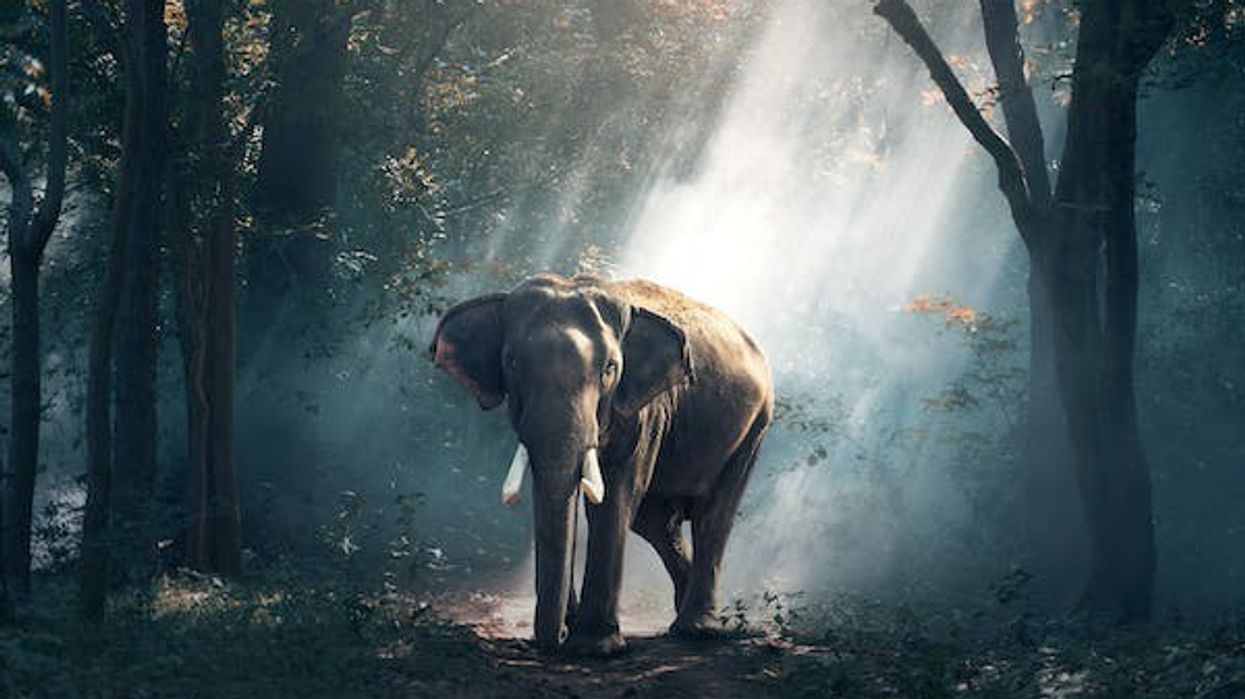Elephant seals are one of the biggest creatures on Earth that are found both on land and in the water, and belong to the genus Mirounga and are marine mammals.
There are two types of elephant seals that come under this genus.
The northern elephant seals and southern elephant seals, though both elephant seals, are similar in every way except for the places in which they live. Though there were traces by the end of the 19th century, of them being on the verge of extinction, their numbers have since recovered.
There is a slight difference of color in both the northern elephant seal and southern elephant seal.
The northern elephant seals are yellowish or gray-brown, and the southern ones are blue-gray.
Elephant seals are classified as marine mammals under the order Pinnipedia and considered as true seals because they don't have ears and have reduced, or very small, limbs which practically help them to swim better, making their body more streamlined.
The disadvantages of this are their short limbs that make it very difficult for them to use them to walk on land as they cannot turn their hind flippers forward to walk.
The body of the elephant seals is covered with blubber, which helps them keep warm and reduces drag while they are swimming.
Due to this these large elephant seals are able to slow down their heartbeat during extreme cold water in Pacific areas and can divert blood flow from the external areas of their body to important core organs.
Elephant Seal Interesting Facts
What type of animal is an Elephant Seal?
The elephant seal belongs to the genus of Mirounga, which are old tribes of seals and animals that live both on land and in the water.
What class of animal does an Elephant Seal belong to?
Southern elephant seals and northern elephant seals both come under the classification of marine mammals as they give birth to elephant seal babies.
How many Elephant Seals are there in the world?
There was a time when both species of elephant seals were under threat of extinction, but over time the population stabilized. Although the total number of the southern elephant seal's population is expected to be roughly 740,000 and the same for the northern elephant seal's population.
Where does an Elephant Seal live?
Both the northern elephant seals and southern elephant seals are seen to be living in different places.
Southern elephant seals are mainly seen inhabitant in large portions of the southern hemisphere which includes lands in Antarctica and islands in the southern part of Africa, South America, and Australia. Northern elephant seals are mostly seen in the coastal waters of the Pacific Ocean from the Gulf of Alaska down to Baja California.
Though both the seals travel a lot during the times of migration or mating or breeding season from ocean to sea including both males and females.
What is an Elephant Seal's habitat?
The habitat of both species of elephant seals isn't that different when compared, it usually consists of large seas and oceans close to land.
Northern elephant seals are fond of residing in terrestrial land which includes sandy, rocky, or muddy shores off the coastline and offshore islands. Southern elephant seals have a similar habitat, they are most likely to be found in the Pacific, Atlantic, and Indian ocean.
Other than that, both elephant seals spend most of their life in the sea or the ocean, and only 10% of their life span is spent on land that during the time of breeding or mating.
Who do Elephant Seals live with?
These elephant seals are very fond of living in packs of the same species which includes both males and females. These animals become very playful when around all the adults and young pups.
How long does an Elephant Seal live?
The life span of elephant seals may differ between the subspecies, in the case of the southern elephant seals, the adult males can live up to 14 years of age, while the females can live up to 20 years old.
In the case of northern elephant seals, it is a bit difficult to calculate their exact life span as they spend most of the year in waters and hardly visit land as there is no possibility to know the natural cause of death, but on average you can see them living up to 11 to 13 years old.
How do they reproduce?
Talking about the reproduction process in both the kind of seals, first of fall there is a very minimal difference, so mostly it is explained together.
They are polygynous in nature, which means only one male elephant seal completes the process of mating with other females in a very large group during the season.
There is a dominant male in each colony that controls the breeding accessibility to the females of the group. On the other hand, less dominant adult males have to continuously fight to gain the position of mating, the dominant ones are called elephant seal bulls, and they fight for the females.
The process of breeding start when the males throw a flipper around the side of a female to grab her neck in his teeth and begin copulation.
Resistance by females results in the males putting their body weight on her.
The breeding season may change in the case of both the northern elephant seal and southern elephant seal as northern ones come out for breeding and birth-giving during the time of December to March. The gestation period of females lasts around 19 days after giving birth and they become sexually mature at age two years old.
In the case of southern elephant seals, the breeding occurs once a year which comes at the end of September, but usually lasts until mid-to-late October and during this time females are in estrus and are most fertile.
The weight of male and female pups differ during birth as males weigh around 27 to 53 pounds and females weigh around 24 to 50 pounds at birth.
What is their conservation status?
There is no conservational threat present for elephant seals, though there was a time when they were considered an Endangered Species. These seals are now well protected under several conservational acts.
Elephant Seal Fun facts
What do Elephant Seals look like?

As mentioned above there is no such difference in the looks of the northern and southern elephant seals, not major just a few much smaller physical differences. Firstly, northern elephant seals are generally brown in color, with some variations available to this coloration.
In males, the coloration is somewhat darker brown, and females are a light tan in color. After a short time of molting, the hair from their body may be completely reduced.
On the other hand, newborn seal pups have little hair present, also they shed their black coat which is replaced by a lighter one.
They both possess two, lobed hind flippers sidewards. Southern elephant seal males are bigger in size than females and grow the signature proboscis present on their faces.
Males may have a lot of scars on their faces due to all the fights they may be part of. Lastly, the southern elephant seals are endothermic in nature which means they produce their own heat.
How cute are they?
Elephant seal pups can be considered cuter in comparison to the adults.
How do they communicate?
The communication skills include elephant seal sounds which they create during the time of fighting which they do in search of new females or during the mating season.
How big is an Elephant Seal?
The justification of elephant seal size comparison would be best done among the species itself.
As the northern and southern ones are not much different in any aspect, in northern marine seals the size may range between 9.19 to 19.69 feet, with an average of 14.76 feet and in southern marine seals the size may range from 9.84 to 16.40 feet long.
How fast can an Elephant Seal swim?
The swimming speed of these two sea creatures is found to be somewhat very similar, they can move at a speed of 3 mph (5 kph) while on land along the ground, and in the water they can move at speeds around 3 - 6 mph (5 - 10 kph).
How much does an Elephant Seal weigh?
In both types of elephant seals, the males weigh more than females, as in southern males and females weigh around 400 to 3700 kg in a range and in northern 600 to 2300 kg.
What are their male and female names of the species?
No names given to males and female species of the elephant seal family.
What would you call a baby Elephant Seal?
An elephant seal baby is called a pup.
What do they eat?
The elephant seal's diet includes different types of squid, cephalopods, skates, small sharks, and fish.
Are they dangerous?
No these seals are not at all dangerous to human beings in any way.
Would they make a good pet?
No seals are not meant to be a pet, they are wild animals and far too large for anybody to keep in their home.
Did you know...
Elephant seals get their name from the large proboscis of the adult males (bull), which looks like an elephant’s trunk. During the mating season or molting, they must avoid cold water and rest on land, in a safe place called a 'haul out'. Unlike any other ocean animal, they can hold their breath for more than 100 minutes.
Why do elephant seals have big noses?
First of all elephant seals got their names due to that elephant-like trunk nose and the sole purpose of that nose is to scare away other males while fighting for females.
What's a group of elephant seals called?
Elephant seals are highly social and live in large groups during the mating season, these groups are known as harems.
Do elephant seals eat penguins?
No, elephant seals don't eat penguins, instead, leopard seals and sea lions eat penguins.
Here at Kidadl, we have carefully created lots of interesting family-friendly animal facts for everyone to discover! Learn more about some other mammals including southern elephant seals and fur seals.
You can even occupy yourself at home by drawing one of our elephant seal coloring pages.










